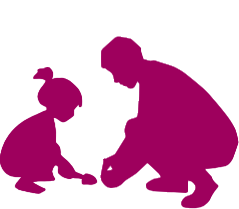A routine is an activity done during the day with a set of steps in the same order. Brushing teeth and getting ready for meals or going out are some examples. Play routines include singing, dancing and people games like peekaboo or hide and seek.
Routines give children the structure to learn. Because the steps happen in the same order, children can predict what’s next, learn skills and ask for help if needed. As time goes on, they do more of the steps and become independent.
Children learn routines by copying parents or siblings. Visuals and social stories can be used to help prompt the steps. Songs can make them fun. Creating a new routine needs a purpose. It could encourage more time together as a family, or have a child gradually take charge of an activity that helps a family get through the day.
During these challenging times, families may feel that routines have changed. Many are still the same, like eating, sleeping, and getting dressed. However, here are some that need to be adapted for COVID-19:
Hand hygiene
Always wash hands before meals and after returning from outings. Children need to know the importance of hand hygiene to avoid catching the virus. Introduce a visual or other support to encourage your child to wash hands thoroughly for 20 seconds and washing more frequently during the day.
With social distancing rules, it’s important to follow the latest government guidelines. If your child needs to accompany you on an essential outing, such as to a shopping centre, help or have them apply hand sanitiser, especially after using stairs or escalators. Avoid touching surfaces as a general rule.
Exercise and play
Social distancing also means that more children’s exercise and play may need to happen at home. Many families are using kids yoga programmes on YouTube. Set up a time of day for the routine, have a five or ten-minute session and then turn off the TV or mobile device at the end.
With TV and videogames, general guidance recommends no screen time for children under two years old, one hour for pre-schoolers from three to five, and two hours for five- to eight-year-olds. However, not all screen time is equal. Time, where an adult is engaging with a child in what’s happening, is more valuable than solo screen time. Every family is different, so work out what is best for you.
While working at home, parents may be looking for ways their children can be more independent in their play routine without using mobile devices. Try bringing some toys out from storage that your child had outgrown, but can use without supervision.
While outdoor activities like cycling and scootering have boomed, aim to keep them for exercise only and not for relaxing. This helps decrease contact on benches or surfaces that may be contaminated by the virus.
Some children may need to go slow for a while to not get worn out. There might be some days they can’t go quite as far. You could bring your children home on your shoulders if they’re tired and push the scooter back rather than finding a place to rest.
Home learning
There’s a lot of tips in our home learning blog. Also try having your child bring their stationery and learning materials to the table, and writing their name at the top of the page or worksheet at the start. This routine can help them become familiar with the new learning arrangements.
Looking after yourself and doing routines together
Don’t forget to take a break, as parents are putting a lot more pressure on themselves during these times. You might need to rest with a hot drink and some music in another room while the kids are occupied. Find the time to keep a hobby or craft going.
Try to include children in your daily routines. Four- to five-year-olds can join a parent in the kitchen and help with cooking, like washing fruit and vegetables or getting bowls and cookware ready. Older children could help prepare morning tea and incorporate some maths, like cutting fruit into a number of pieces or counting spoonfuls of ingredients. This can help take the pressure off parents from having to think of an activity for children and caring for them.
Sometimes things don’t go to plan. It’s natural that tensions may arise in the household with COVID-19 restrictions. Calm communication with children at busy times can help with getting through the day.
Scheduling and transitioning routines
We have so many mini routines that they can almost join together into a list of things to do during the day. Pressure can come from thinking a task needs to be finished by a certain time to move on to the next activity.
Children may feel overscheduled as a result. Try leaving out one or two activities on days when your child is tired or unwell and completing tasks take longer. You could also help do more steps of the routine to get things going.
As children become older, parts of some routines need to change. It may be moving from co-sleeping to sleeping independently or transitioning from milk teeth toothpaste to an adult toothpaste. For all ages, help the child to understand the new routine and give lots of praise for encouragement. However, with homeschooling and other adjustments due to COVID-19, it’s probably best to leave big transitions to a later time.
Setting up good routines does not only help with getting through the day. They make children feel safe and confident. They can also help bring the family closer together.
Resources
Communication board to help children stay safe from germs
Songs to guide children through daily activities
We may be physically distancing because of COVID-19, but Plumtree is here to help. Please talk with your Key Worker if you have any questions and get the most out of this challenging time.
This Blog Post was compiled from an interview with senior Speech Pathologist, Julie Cowmeadow.










